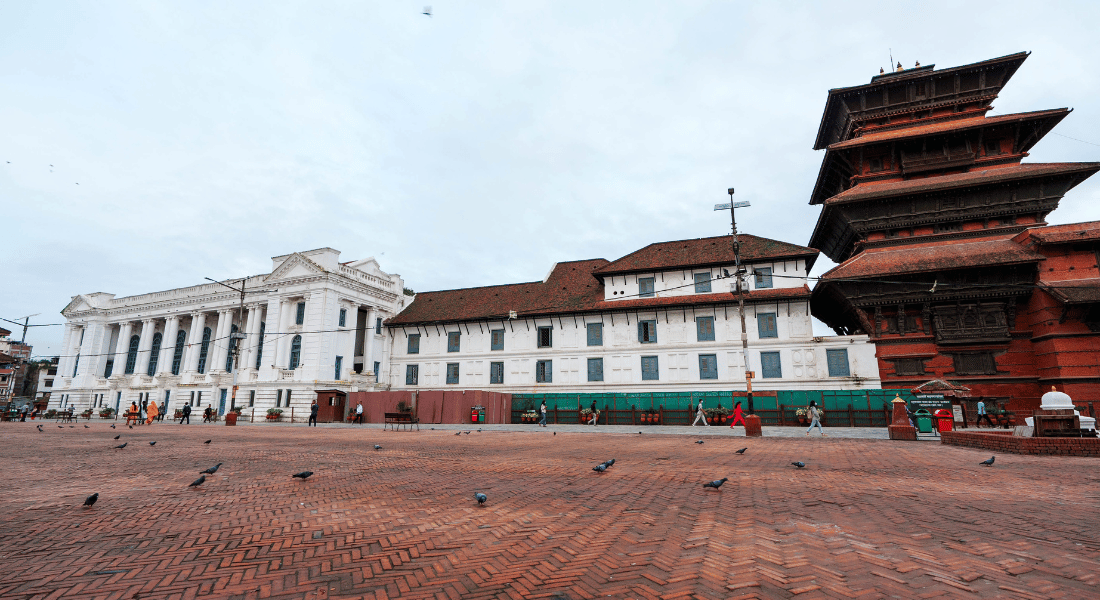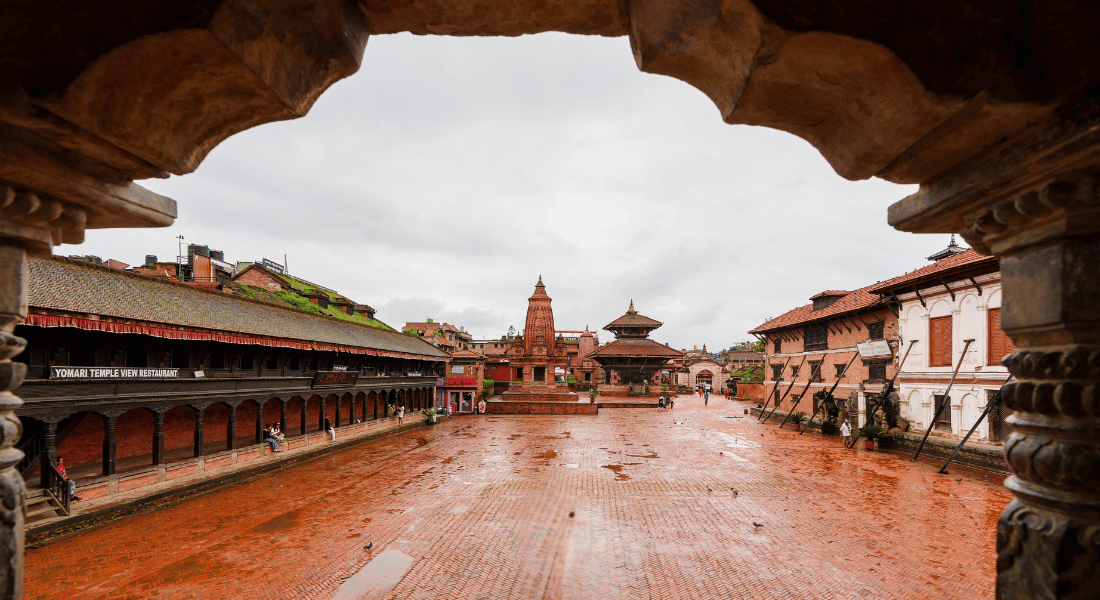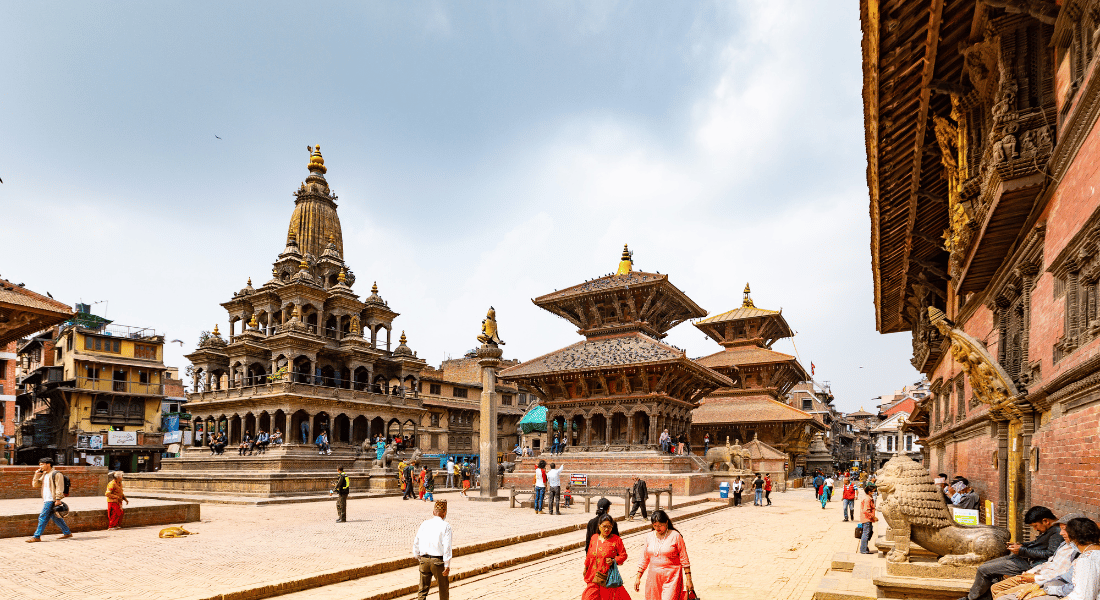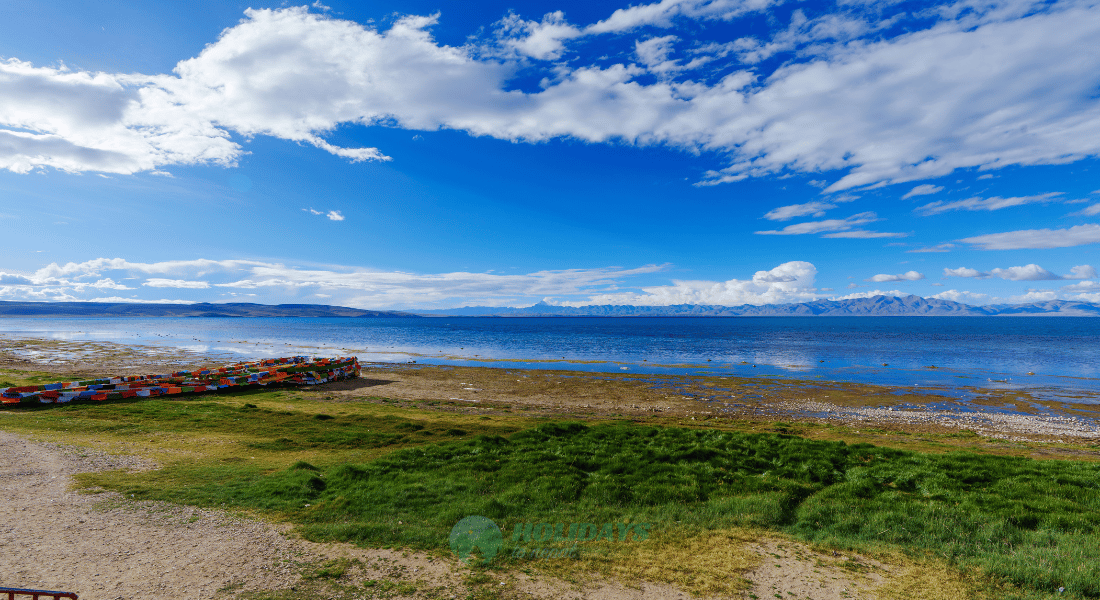Nepal has some of the most interesting and beautiful history, which can be simply portrayed through fascinating landmarks and rich culture. The country is rich in both natural and cultural aspects and numerous natural and historical landmarks make Nepal a marvelous place for travelling. There are hundreds of spectacular historical beauties throughout Nepal; however, the concentration is high in the Kathmandu Valley, which is also known as the city of temples. Hundreds of historical architectures date back to centuries and Kathmandu Durbar Square is one of them.
Kathmandu Dubar Square is one of three Durbar (Royal Palace) Squares inside the Kathmandu Valley that is listed as a UNESCO World Heritage site, which once used to be the residence of the country's royal families. Given its close ties to the royal family in the past, it holds significant historical, cultural, and religious significance that we will discuss slowly. Thousands of people from across the world visit the square with different purposes: some come to experience the rustic beauty, some to learn about history, and some to see the marvelous art techniques used back in the days that surpass the limitation of creativity and finely detailed handwork. Kathmandu Durbar Square, also known as Basantapur or Hanuman Dhoka, is one of Nepal’s historic landmarks with tremendous history and beauty. It is located in the heart of the hustling and bustling Kathmandu city, surrounded by the daily chaos and people from all around the country. It has become one of the most popular tourist sites, as it always amazes people with its pure beauty and remarkable art along with the peaceful vibe inside the square.
The remarkable Durbar Square features some of the most fascinating architecture from different timeline with a strong influence on the landmarks according to different eras.
Table Of Content
Kathmandu Durbar Square Facts
Here are some facts about Kathmandu Durbar Square:
|
Site |
Kathmandu Durbar Square |
| Other Names |
Basantapur Durbar Square Hanuman Dhoka Durbar Square |
|
Location |
Kathmandu, Nepal |
|
UNESCO World Heritage Site |
1979 AD |
|
Area |
2.5 Acres |
|
Founded By |
Shankerdev (1069-1083) main palace |
|
Historical Significance |
Residence of the Royal families |
|
Architectural Style |
Pagoda Style (Major) |
|
Key Attraction |
|
|
Major Events Held |
|
|
Entry Fees |
SAARC: 500 NRP Foreigners: 1000 NRP (Free for Nepalese Citizen and children below 10 years) |
|
Opening Time |
Durbar Square: 24/7 Tribhuvan Museum: 09:00 AM - 05:00 PM |
Kathmandu Durbar Square History
The great Kathmandu Durbar was established in the early Lichhavi period between 450-750 CE. Nepal went through many changes throughout time and there is no solid evidence on who established Durbar Square; Sankara Deva is credited for the construction of Durbar inside the square. Kathmandu Durbar Square was not always packed with historical monuments; they were slowly added by different people over time. History is not just about who established what but how it's known in the present and what stories it holds. Below we will be discussing in which era the landmarks were built.
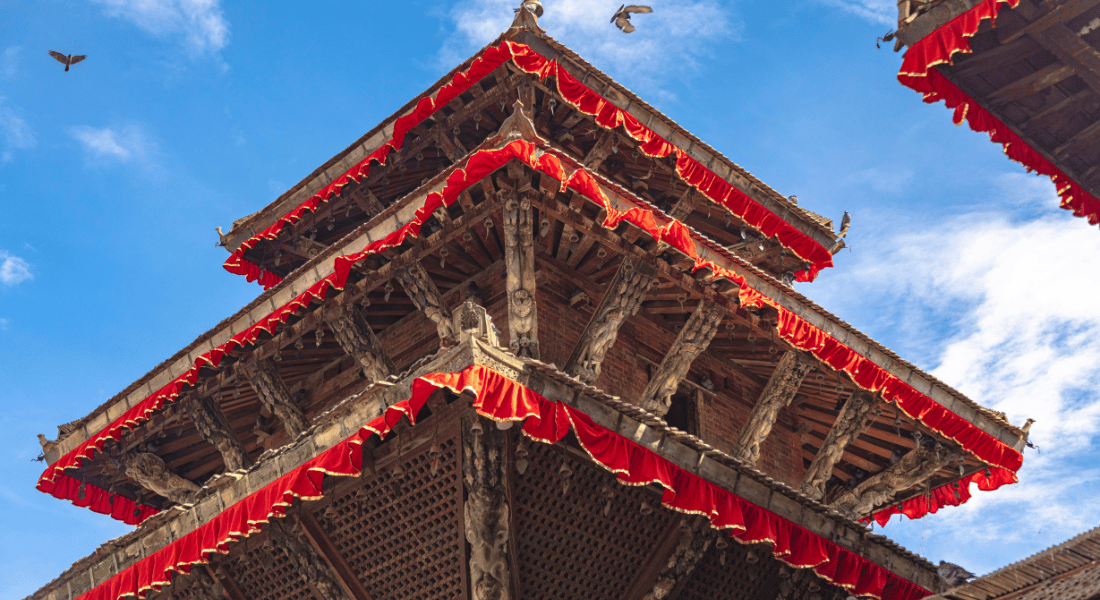
Malla Period: The Golden Age of Nepal. (1201-1779)
The Malla period/dynasty is also known as the Golden Age of Nepal and in this era, most of the temples and architecture you see now were added. However, due to several renovations and reconstructions, it is hard to find the original state/pieces of the landmarks. The art and culture of that era have formed history because the cultural, economic, and political aspects of the country were at their peak during this time. Let's say they were literally making history; artisans were encouraged to show their skills through different types of techniques such as sculpture, wood carving, and metalwork, which one can see all over the Durbar Square. During this period the Newari art style was more prominent (Newars: The native residents of the Kathmandu Valley). Malla kings have contributed to the great construction of the palace complex in different locations besides Kathmandu, such as Patan and Bhaktapur, leaving behind rich architectural marvels that we appreciate today.
Malla kings ruled over the Kathmandu Valley from 1201 - 1769 and they were the Kshatriya monarchs that succeeded the Licchavi Empire. They introduced reforms in legal codes and religious, political, and socioeconomic aspects of the country, and with that, the culture and art of the region prospered. The Malla dynasty was divided into three kingdoms in the late 15th century: Kathmandu (Kantipur), Patan (Lalitpur), and Bhaktapur (Bhadgaon), thus the higher concentration of remarkable architecture in these places. During the Malla era, several monuments were built across the valley, specifically inside Kathmandu Durbar Square, where the following landmarks were built.
Different Malla kings ruled during the Malla Empire, and Ratna Malla (1484-1520) was the first to break from a collective rule established by his grandfather and chose to govern Kathmandu, then known as Kantipur, independently, making Kathmandu Durbar his official seat, starting the developing journey of Kathmandu Durbar Square. However, he didn't contribute much to building the architecture but he made the path for other kings to add structure to their residence.
After Ratna Malla came Mahendra Malla’s rule (1560-1574), and during his time he contributed to building some of the most important temples and palace complexes. Starting strong in 1563 under his rule, one of the most unique temple complexes, Jagannath Temple, was built. After that, in 1964, the Taleju temple was built, reflecting the Newari architectural style with three roofs dedicated to Goddess Taleju, who was believed to be the protective deity of the royal family and the nation itself. Similarly, the Kotilingeshwara Mahadev, which is made out of stone, and another Mahendraswara temple carved in the form of Shiva linga, both dedicated to the Hindu deity Shiva, were built during King Mahendra’s rule; however, the exact date of their construction is not mentioned. After Mahendra Malla came to the rule of Shiva Simha Malla (1583-1619), who was one of the most ambitious kings who conquered other regions around Kathmandu, such as Patan and Dolakha, and expanded his kingdom. Alongside, he also contributed to the construction of the Taleju Bhawani temple dedicated to the Taleju goddess.
After him came Pratap Malla (1624-1674), one of Nepal's most popular Malla kings, who contributed significantly to the art, architecture, and literature that made his empire the most impactful even to this day. During his rule, most of the architecture that is present today was built, such as small entrances intricately decorated with deity paintings and wood carvings, temples, palace complexes, courtyards, and many more. The landmarks built during his empire are listed below:
-
Octagonal Krishna Mandir (temple) (1648-49).
-
Mohan Chowk and Sundari Chowk (1650).
-
Stone inscription dedicated to goddess Kalika, which was written in 15 different languages (1664).
-
Placed a statue of Kal Bhairab, which is believed to be the fearsome form of Shiva, near the Jagannath temple.
-
Renovated the main wooden door of the Taleju temple with an intricately designed metal door (1670).
-
Pratap Malla’s column features his statue with folded hands surrounded by his two wives on each side and his 5 sons around him (1670).
-
Renovated Degutala temple and Taleju temple.
-
Shiva temple and Indrapura near to his palace.
-
Engraved songs on the walls of the Jagannath temple.
-
Build Kavindrapura, which is known as the mansion of the king of poets.
-
Restored the Lichhavi stone sculpture of the Jalasavana Narayan, Kaliyadamana, and the Kal Bhairab.
-
Lastly, after consulting with the Tantric leader, he ordered a stone image of the Hindu deity Vishnu in incarnation as Nara Simha.
Later on, after Jaga Jaya Malla (1722-1736) succeeded Pratap Malla and during his empire, he contributed to adding the Narayan temple, now known as the Bhagwati temple. It doesn't seem to have much contribution but it is one of the most important temples inside the Kathmandu Durbar Square in the present date. After Jaga Jaya Malla, the last king of the Malla dynasty, Jaya Prakash Malla (1746-1750) took over, and during his empire, the Kumari Bahal, also known as Kumari Ghar (house), was built, where till this day the living Kumari resides. During the Malla dynasty, they also contributed to building landmarks in other regions such as Patan and Bhaktapur so it was the golden age for Nepal in terms of art and architectural aspects.
Shah Period (1769-2008)
The Shah Period, also known as the Shahs of Gorkha or the Royal House of Gorkha, was the last ruling dynasty of Nepal, keeping their empire from (1769-2008). Shah kings ruled for 240 years after Prithvi Narayan Shah unified Nepal in the mid-18th century. During their empire, Kathmandu Durbar Square went through several changes. After Prithivi Narayan Shah unified Nepal, he declared Kathmandu (Kantipur) the capital city of Nepal and made Kathmandu Durbar his residence. During his empire, he contributed to adding some of the most important structures. His first contribution to the square was to install the idol of Bhagawati in the ancient, stone Narayan temple, converting it from Narayan to Bhagawati. Next, he built a 9-roofed landmark called Nautale Durbar at the end of Nasal Chwok on the eastern side of the palace. Similarly, Basantapur Chowk was built to showcase the gorgeous woodcarvings around the structure and the roof inspired by the Mughal style. After him, Rana Bahadur Shah succeeded and during his rule, he contributed to building the Shiva Parvati temple (Nava Jogini). Besides that, he also donated the metal-plated head of Swet Bhairab near the Degutale temple during the Indra Jatra in 1795 and a “Tago Gan” (huge bell) as an offering to Degu Taleju in 1797. His efforts to unite Nepal as a single nation were among the greatest he could have done, regardless of his seemingly small contribution to Durbar Square.
Rana Regim (1846-1951)
The Rana dynasty, also known as the Chhetri dynasty, the wolves in sheep’s clothing, began their rule with a rather gruesome Kot Massacre of the Thapa family, which held immense military and political power during that period. After the massacre, the rise of Jung Bahadur Rana started with all the military and political power in their hands (1846-1951). [Fun Fact: Although the Rana’s were never officially crowned as the kings of Nepal, they held all the power to themselves and the very Shah monarchy they were supposed to protect was stripped of its power and the kings became mere puppets in their hands. During this era, Nepal was mostly isolated from the world yet ironically the influence of the outer world was limited to the Ranas and not the public. Besides the uncomfortable history of the Rana empire, they contributed to updating the Durbar Square by building a neoclassical Gaddi Baithak by Chandra Shamsher, which simply translates to ‘’Royal seat’’ for the important so-called royal ceremonies and hosting the important guests. It was by far the most unique architecture for that time, as it was inspired by European design in 1908 regardless of being isolated from the outer world. Besides the Gaddi Baithak, they contributed to several other structures outside of the durbar.
25th April 2015 Earthquake - Black Day for Nepal
A devastating day for Nepal, the Gorkha Earthquake, one of the strongest to ever strike the country in over 80 years, destroyed over 600,000 structures, with Kathmandu Durbar Square being the most severely affected one. It was not just a natural disaster but a heartbreaking event that wiped out centuries-old history and the legacy of all the empires that ever ruled over Nepal. This event destroyed hundreds of landmarks beyond repair, including the precious lives of approximately 9,000 people. Below is a list of some of the important monuments that were destroyed during the tragedy, along with information on whether or not they have been repaired/restored.
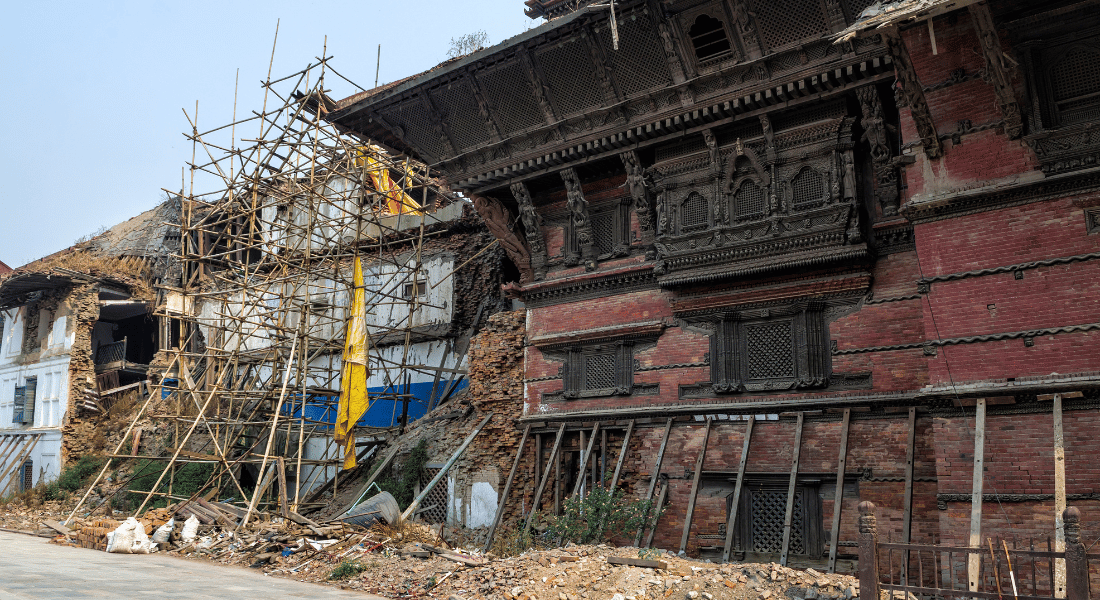
The following monuments were completely destroyed
-
Kasthamandap (restoration completed in December 2021)
-
Maju Degu and Narayan Vishnu Temple (early 2024; however, the white Shikkara temple in front of the temple has not been restored)
-
Trailokya Mohan (2023)
-
Krishna Temple, also known as Chasin Degu.
-
Kakeshwor Temple.
The following monuments were partially damaged
-
King Malla’s Column (restored in 2018)
-
Old Drums (2018)
-
Shiva Parvati Temple (2024)
-
Gaddi Baithak (2022)
-
Basantapur Tower (2023)
Other monuments that are not listed above but were damaged are still in the process of restoration. As they say, "Rome was not built in a day"; restoration and healing take time.
Kathmandu Durbar Square Significance
In addition to being a historical site, Kathmandu Durbar Square is also a place of spirituality and culture, holding the nation's history and legacy for hundreds of years. Every landmark that is or was present inside the square is the embodiment of the nation's rich history that shows the century-old art culture, belief system, and rich tradition that have shaped the rich background of the country. It is one of the few places where the art and culture are still alive, and the monuments have kept them alive in the forms of temples, palaces, and museums that anyone can visit and experience the pure beauty.
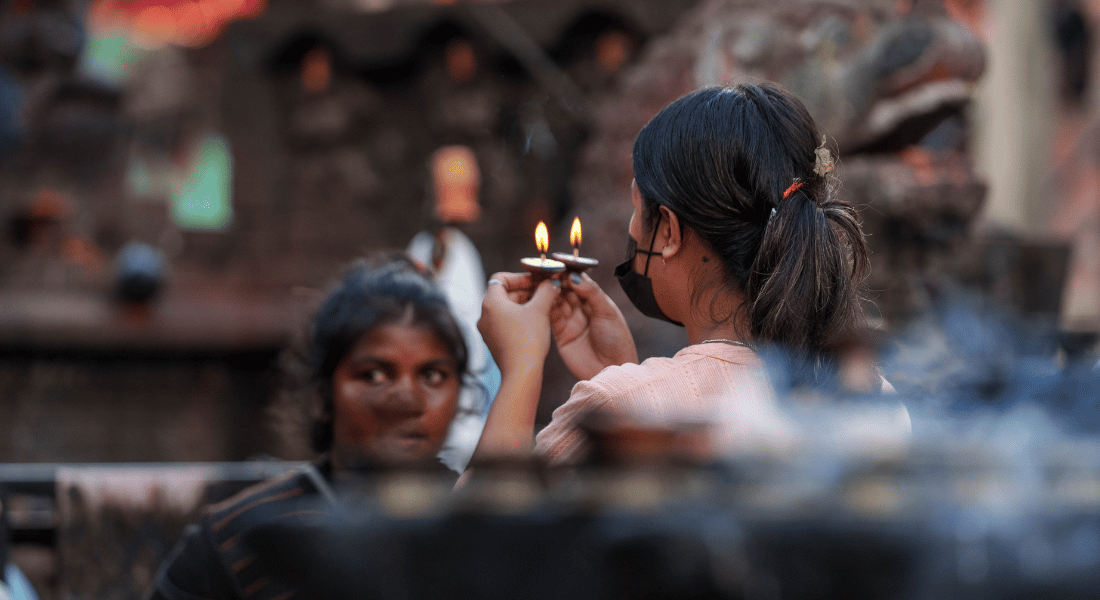
Religious Significance
Kathmandu Durbar Square holds great religious significance for Hindu and Buddhist people, as there are numerous religious landmarks dedicated to different Hindu deities and religious philosophies. Hundreds of people gather daily to worship the idols, temples, and shrines to show their devotion for centuries, making it one of the most important parts of people's lives. It has been the place where religious ceremonies take place, as the place is home to several important temples in Nepali culture/religion, such as Kumari Ghar, Taleju Temple, and many more. Along with the historical sites, the very courtyard hosts a number of magnificent festivals and events each year that preserve the tradition. Festivals such as Indra Jatra and many other religious events held here are proof of how important Durbar Square is.
Cultural Significance
Kathmandu Durbar Square also holds immense cultural significance as it is the core of Nepal’s cultural and archaeological history. Inside the square, there are more than 50 landmarks built in different times and empires that feature various cultural and religious values. Each structure showcases the rich heritage of Nepal, from traditional Newar art to stunning architectural marvels. The square where the kings of Nepal lived, where they were crowned, and where major historical moments took place is a center of art, culture, religion, and history. The ancient culture is what gives the nation its true identity; each brick and strut screams the glorious history of ancient Nepal.
Kathmandu Durbar Square Attractions
As already mentioned, Kathmandu Durbar Square is not a single structure but a cluster of several religious landmarks, a palace complex, and some fascinating architecture that holds the century-old history and legacy of the numerous rulers and empires. These architectures are engraved with different cultural and historical significance along with beautiful and unique art styles. Most of the structures you will see inside the square are built by the natives of the Kathmandu Valley, who are called Newars, and they have a unique art style that separates them from others, such as intricate wood carving, metalwork, and sculptures as well. These art forms are used while building the monuments that will fascinate you. Now some of the most popular/important monuments are listed below with brief descriptions.
Kotilingeshwor Mahadev Temple
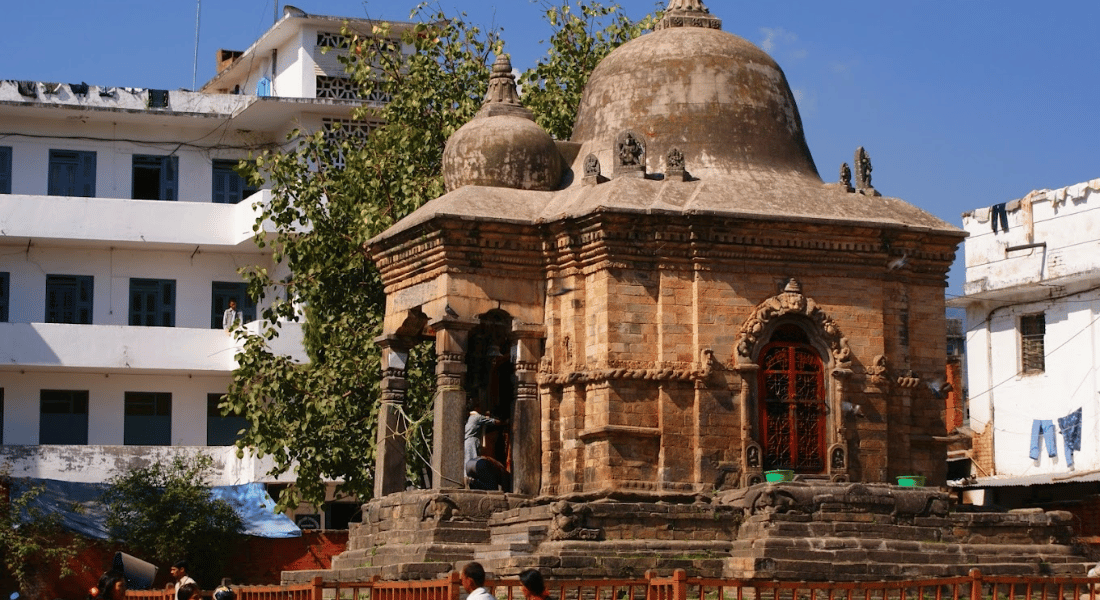
It is one of the temples inside the Hanuman Dhoka Durbar Square, which stands on the northwestern side of the Hanuman Dhoka palace, directly towards the southwest of the larger and most recent Mahavishnu temple. Built in around 1562, the temple is believed to be the earliest surviving Sikhara-style temple inside the Kathmandu Valley. Inside the temple is a four-faced statue of Hindu deity Shiva in the form of a Chaturmukha Linga, like in the Pashupatinath Temple, which can be accessed from four directions, as there are four entrances, three of which are closed by steel gates to prevent theft or vandalism. Outside of the temple, several other details depict other celestial beings, such as Nandi (Shiva’s vehicle) and others.
Taleju Temple
Taleju Temple, which is also known as Degu Taleju Temple or Taleju Bhawani Temple, is dedicated to Goddess Bhagawati. The temple was built in 1564 A.D. under the empire of King Mahendra Malla after 46 years of construction, which was built in the shape of ‘’Yantra’’, a mystical diagram said to be suggested by the goddess herself. The goddess was the patron deity of the royal family (Malla dynasty), which remained the same even after the Malla dynasty was over. It is believed that the goddess Taleju provided protection to the nation and the royal family while providing prophetic advice for the betterment of the nation. Now, besides history, another real question is what makes the physical temple so important. Well, the temple itself is called the hidden power center as it has immense spiritual significance. It is not a regular everyday temple, as it is opened once a year for the general public on the ninth day (Navami) of Bada Dashain, which is one of Nepal's biggest festivals.
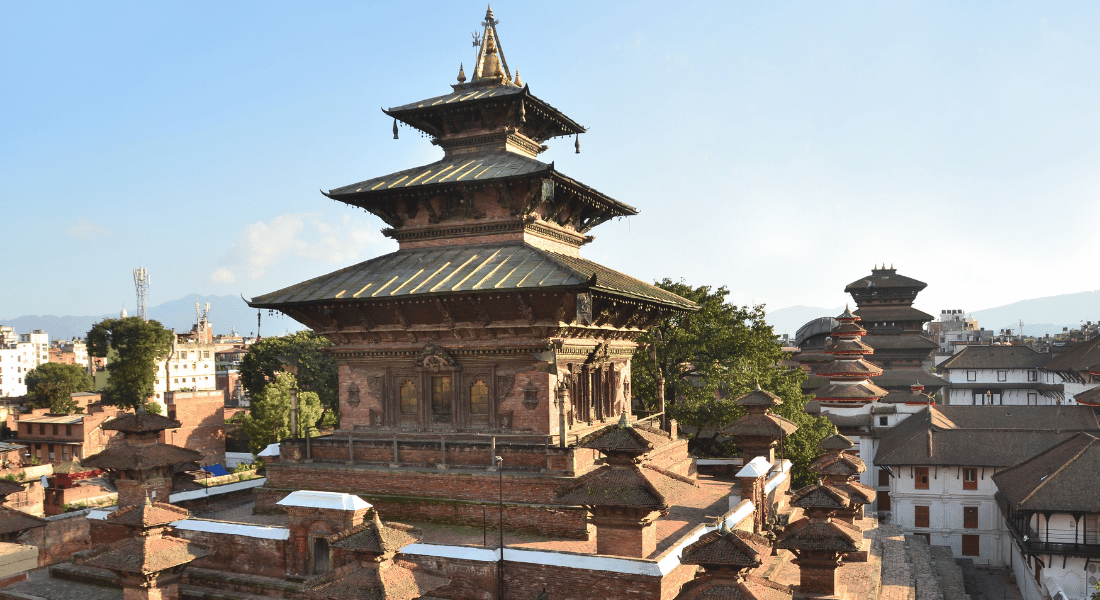
Now, as the temple is not opened often, let me give you a detailed rundown of what this magnificent temple looks like through words. The layout of the architecture is very human, with a multi-tiered structure, several gates, and a strong base that resembles a cosmic mandala. The blueprint was suggested by the goddess herself so it must be perfect. The main building stands tall with three tiers of roofs in pagoda style upon a twelve-stepped base recalling the slope of Mount Meru. Mount Meru is regarded for having a strong connection with Hinduism, Buddhism, and Jain cosmologies. It is said to stand in the center of the universe and is the axis of the world. Around the temple, there are 16 satellite shrines designed as two-level Newar-style temples that contribute to the spiritual and architectural beauty of the temple. The roof of the central building is covered by a gilt copper sheet and is supported by carved wooden struts depicting various deities, adding both structural support and religious significance.
About the entrance, there are four entrances to the temple, one on each side (North, West, East, South), and each path leads to one actual entrance and two false doors. Each door is heavily crafted with intricate wood carvings, wooden colonnettes, a Torana (gateways that mark the entrance, which is believed to be auspicious or protective) over the central entrance, and pointed blocks (Bhailahkva) positioned symmetrically on both sides of the lower jambs of the door. The entire temple is surrounded by a high wall through which for most of the year, no one may enter except the (royal) priests; however, the rules are relaxed slightly during the Indra Jatra, when Hindus and Buddhists are allowed to enter the compound through the Singha Dhoka (Lion Gate), which was designed by King Pratap Malla himself in 1663.
Fun Fact: The temple was previously the tallest structure in the area since the king commanded that no building should be taller than it when it was being built.
Chyasin Dega
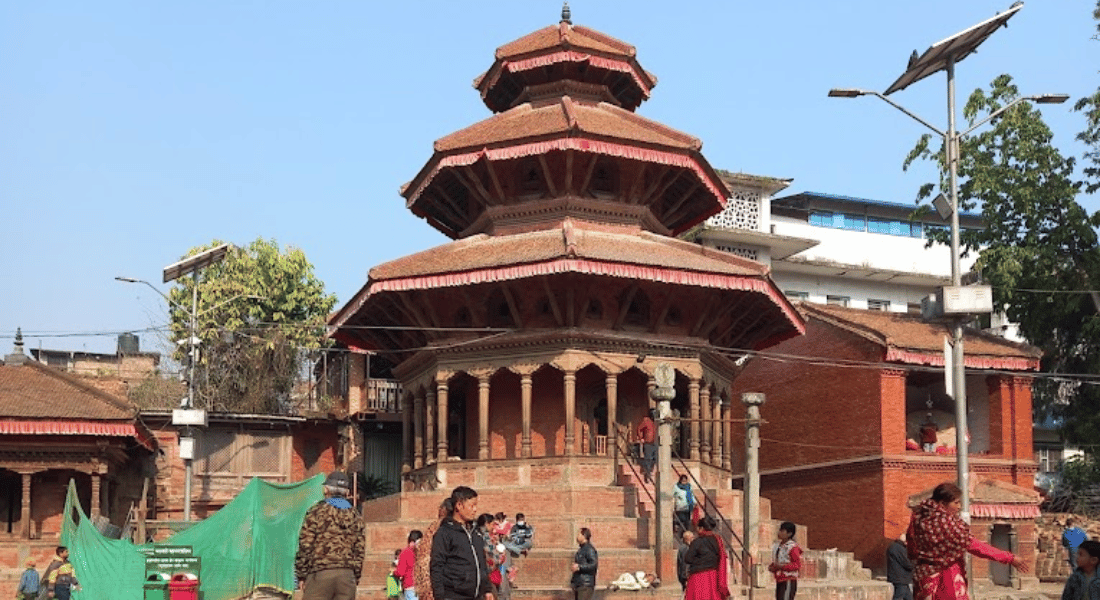
Chyasin Dega, also known as the temple of Vansagopal (which means Krishna in the act of playing the flute), commonly known as the Krishna Mandir (Temple), is dedicated to the Hindu deity Krishna. It was built in 1649 by King Pratap Malla in the loving memory of his two deceased queens, Rupamati and Rajamati. Inside the temple, there are images of Krishna and two goddesses that resemble the king and his two wives. It stands as a testament to the ancient architectural marvel as it represents the intricate octagonal design with fascinating wood carvings and ancient artwork.
Jagannath Temple
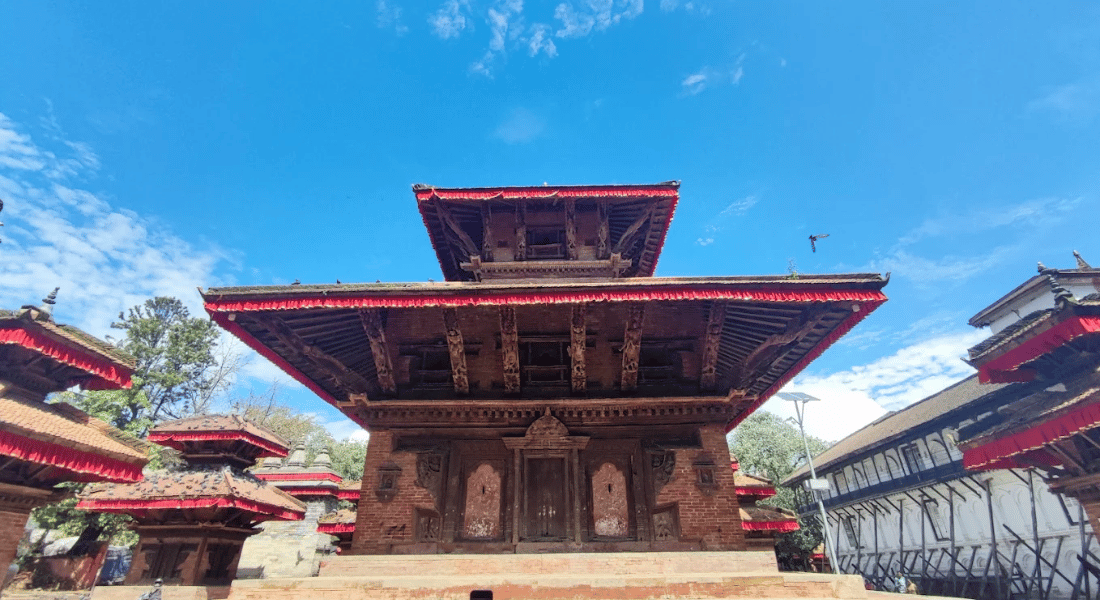
Jagannath Temple, also known as Char Narayan Temple, is one of the oldest temples in the square. It is built in Newar style using bricks and wood and is similar in design to the other temple of Char Narayan in Patan. The architecture of the temple is stunning, as its outer walls lead to three doors with decorative Torana leading towards a passage around a central room that holds the main idol, which can be accessed only by the priests. Unlike other temples, the passage is blocked at two corners that separate the shrine from the main image. Besides its fascinating interior, it is also known for its exterior design, which features erotic carvings on the roof beams that represent fertility and other spiritual significance.
Maju Dega
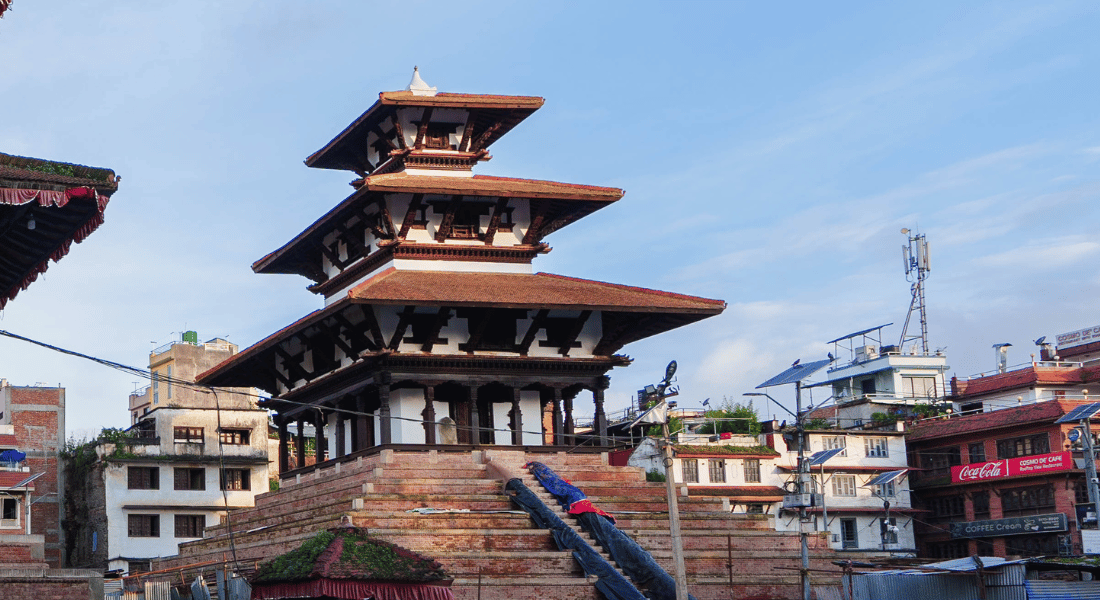
Maju Dega, which translates to Mother-in-law Temple in the Newari language, was built in 1690 and is dedicated to the Hindu deity Shiva, which gives the temple its other name, Mahadev Temple. It was built by Queen Ridhhi Lakshmi during the empire of her grandson Bhupalendra Malla, who became king at the very tender age of 8 and unfortunately died at the age of 21. The temple complex itself is just three tiers tall; however, as the temple stands at the pyramid-like base, it appears taller than its actual height. To reach the temple one needs to climb nine steep brick bases, which gives the temple its dominant look over the skyline. There are wooden doorways, columns, windows, and supportive beams, all beautifully carved, leaving intricate patterns and figures of Hindu deities both on the outside and inside of the temple.
Trilokya Mohan Narayan
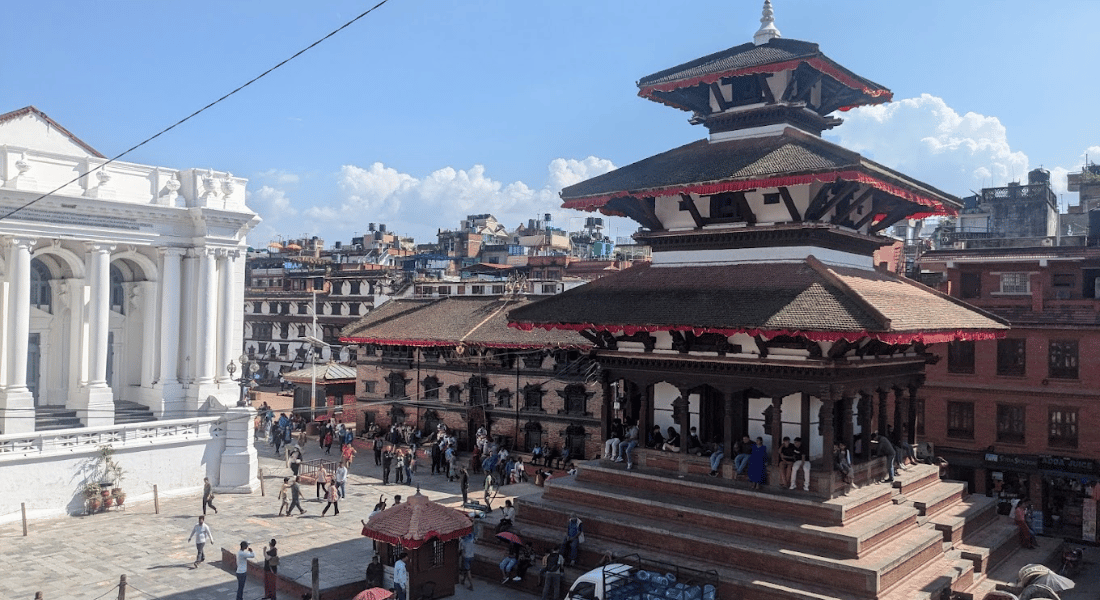
Trilokya Mohan Narayan, which means Vishnu of the three worlds, is also known as the Dasavatara Mandir, which means Temple of the ten incarnations of Vishnu in the Nepali language. It was built by Parthivendra Malla in honor of his deceased brother Nripendra Malla in 1674 and later, after a few years, in 1689, Nripendra’s widow Riddhi Lakshmi and her chief minister sponsored a votive Garuda statue in a kneeling position facing towards the temple’s west face. The elegant temple is set on a five-story platform on the south side of the square, bounded by the Shiva-Parvati temple on the north side, Hanuman Dhoka on the east, and Maju Dega to the west. The roof of the temple is lavishly decorated with various incarnations of Vishnu along with other associated deities, giving it its iconic name, Dasavatara Dekhaune Mandir (10 incarnations showing temple).
Shiva-Parvati Temple
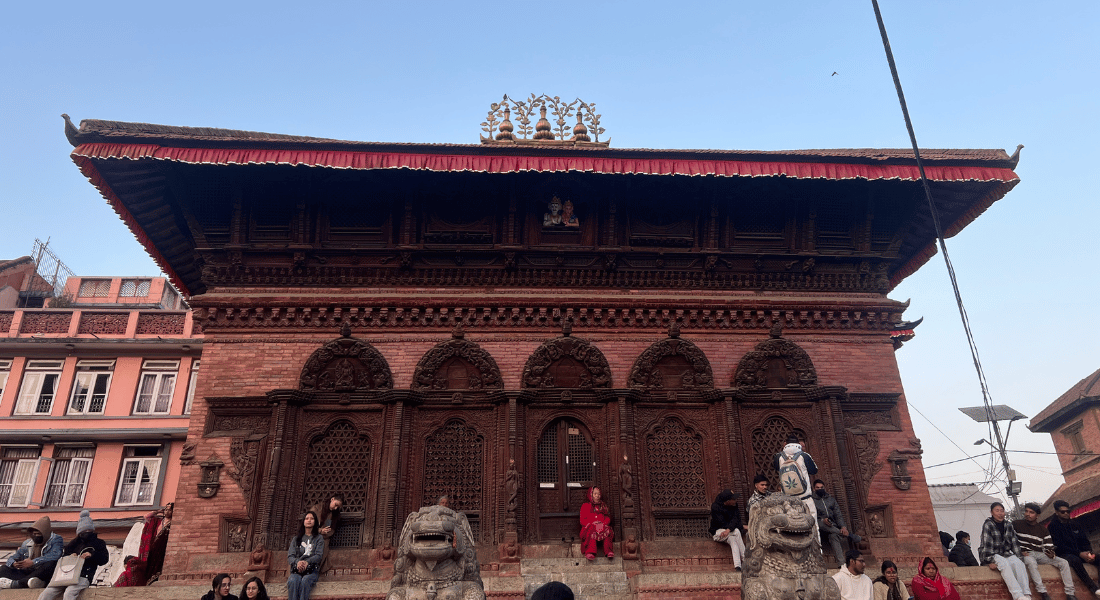
The Shiva-Parvati temple, which is known as the Nava Jogini or Navadurga Temple, refers to the nine manifestations of the Hindu deity Durga. It is located in the southwest of Basantapur in the heart of the town square and features a rectangular two-story building facing south, standing directly northeast of Maju Dega. unlike other temples inside the square, it features a two-story building with only one roof. It is known as the Shiva-Parvati temple, as it is dedicated to Shiva and Parvati. The upper floor features a pair of mannequins of Shiva and Parvati together glaring outside of the window.
Kasthamandap
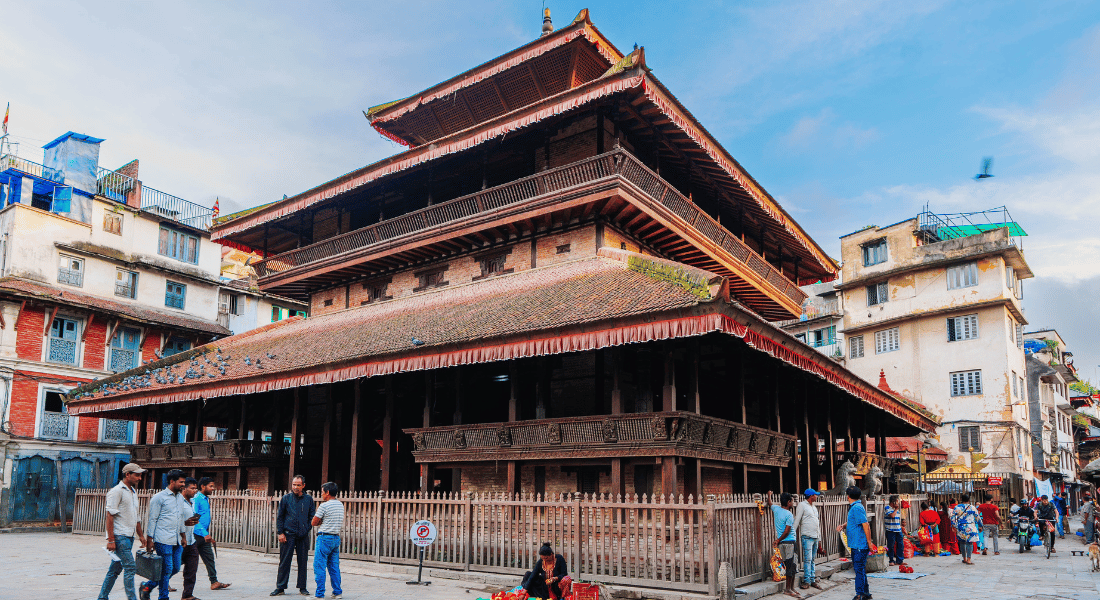
Kasthamandap, also known as Maru Satta, which translates to wood-covered shelter, is a big open temple that is believed to have been built from a single tree. It features a three-story structure that has an open ground floor for the public. Inside the building there is an idol of Gorkhanath and at each of the four counters is an image of the Hindu deity Ganesh, which was believed to have been constructed in the 12th century and renovated several times.
Kal Bhairab Statue
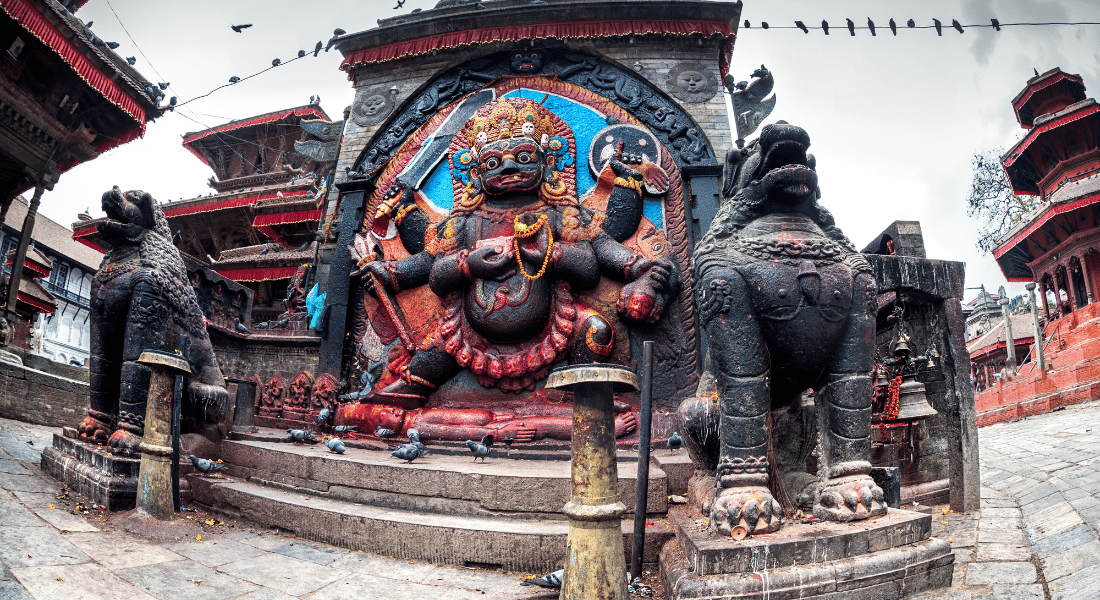
The Kal Bhairab statue is the idol of the fierce avatar of the Hindu deity Shiva, also known as the lord of time and death. The statue and the surrounding structures are made of stone and were carved around the 15th century. It was discovered by King Pratap Malla in the paddy field around the 17th century and was installed in Dubar Square. Back in the day, it was believed that anyone who lied while swearing an oath in front of Kal Bhairab would face divine punishment, and later on, it was also used by the government as a place for the public to swear the truth for any crime. The statue features a standing position in a fierce form, stepping over a dead body and holding a decapitated head in one hand. The idol is believed to be the protector of Kathmandu and the chief of the justice giver and is regarded as a revered religious place.
Degutalle Temple
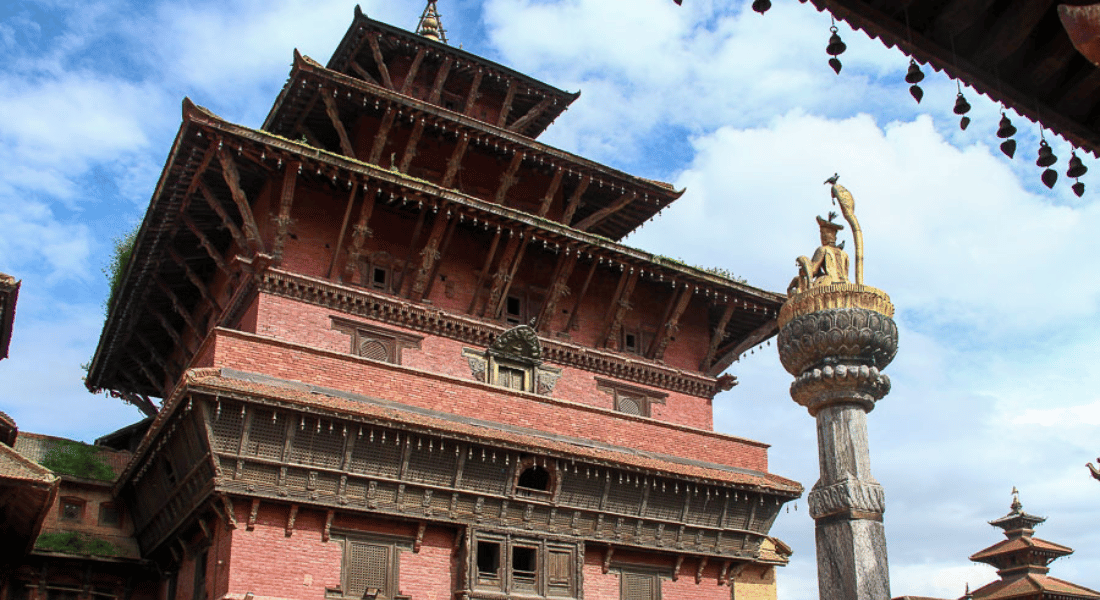
Degutalle, which means Temple of the god/deity in the Newari language, is another significant temple complex inside the Durbar Square. It is a part of the old palace complex built on the second floor, which can be accessed just from the inside of the palace, restricting the general public from accessing the temple complex. The temple structure dominates the view of the palace, with its three-storey roof and golden pinnacle. It is dedicated to the Royal Malla family deity, Taleju, which symbolizes power, protection, and divine favor upon the Malla kings. The temple also holds strong tantric significance, where they performed religious practices justifying the architecture of the complex.
Hanuman Statue
The Hanuman Statue is a kneeling figure of Hanuman, the Hindu god who is always depicted as a monkey, which is believed to be an avatar of the Hindu deity Shiva. The statue sits tall on a stone pedestal constructed by King Pratap Malla in 1672, along with other great monuments inside the Durbar Square. The statue itself is cloaked in a red cloth and sheltered by an umbrella marking the Dhoka (entrance) to the palace, which has given its unique name, Hanuman Dhoka Durbar (Hanuman entrance Palace). The face of the statue is not seen as it is covered in layers of orange/redis vermillion paste applied by generations of devotees covering its face completely. On each side of the statue are the double triangle flags of Nepal, symbolizing protection towards the nation.
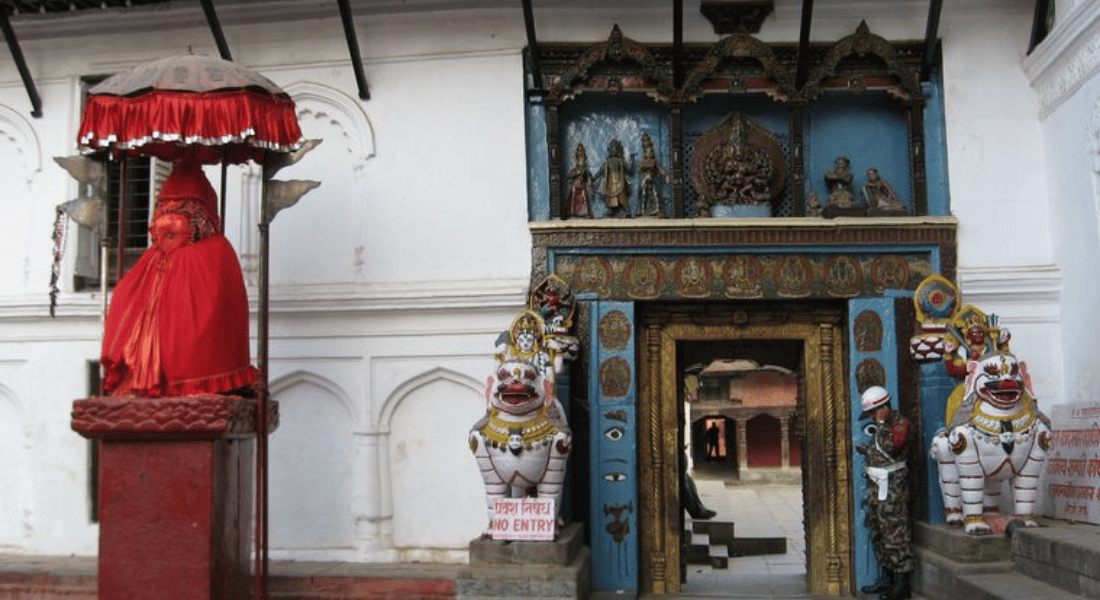
The entrance leads towards the iconic Hanuman Dhoka Palace and before you enter the palace, there is a gorgeous gate with incredible details. The gate itself is golden with a beautiful design and above the gate are brightly painted statues; in the center above the gate is a figure of a fearsome Tantric version of Krishna and on the left side there is a gentler version of Krishna in its typical blue skin tone accompanied by two Gopi (milkmaids) and on the right side sits the statue of King Pratap Malla in a kneeling position and his wife in a casually sitting position.
Hanuman Dhoka Durbar
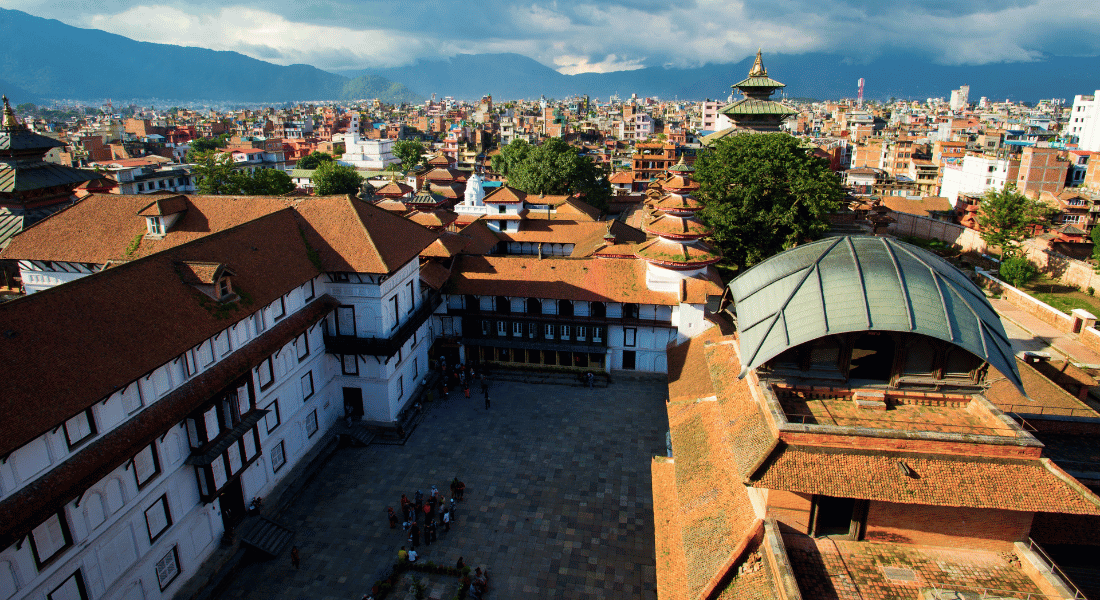
Hanuman Dhoka Durbar's name came from the statue of Hanuman established in front of the entrance of the palace. The palace complex was originally founded during the Lichhavi period but most of the structure you see now was added by the Malla kings and was renovated multiple times. The architectural remains and artifacts within the palace are from different empires of Nepal, such as Malla, Shah, and Rana. The Durbar Square is divided into two parts, the outer palace complex and the inner palace complex. The outer complex contains fascinating temples such as Kumari Ghar, the Shiva Parvati temple, and many more. The inner palace complex contains the old palace complex, Hanuman Dhoka, and its beautiful courtyards such as Nasal Chowk (courtyard), Mul Chowk, Sundari Chowk, Lohan Chowk, and Mohan Chowk.
Basantapur Durbar
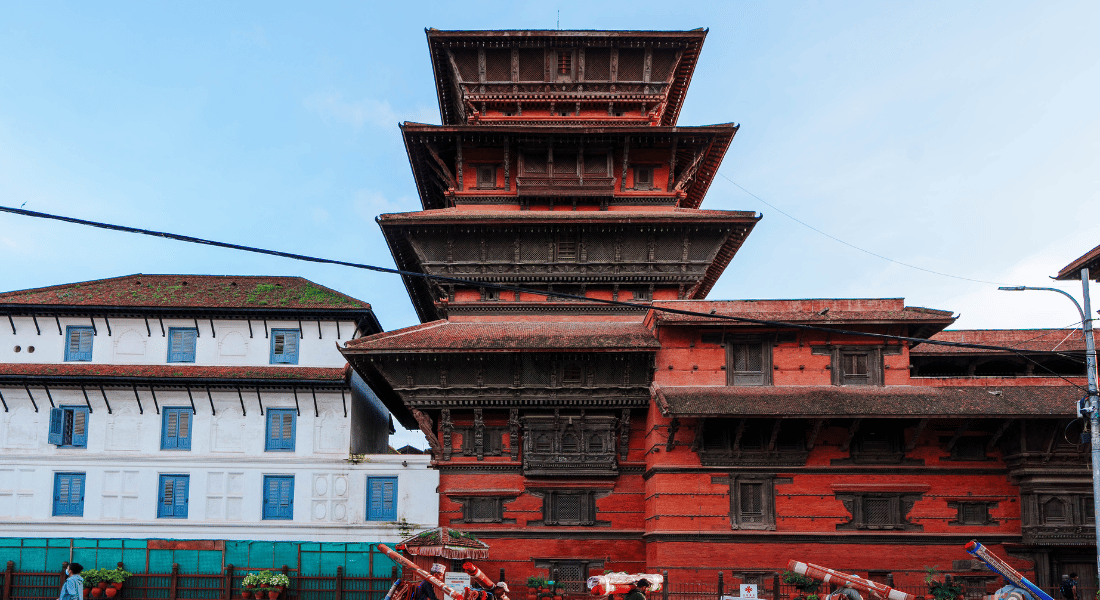
Basantapur Durbar, which is a part of Hanuman Dhoka Palace, also known as the Nautalle Durbar, which translates to a nine-storied palace, was built by King Prithivi Narayan Shah. The Basantapur Durbar was built in (1170-1179) soon after taking control over the Kathmandu valley. It was a one-of-a-kind landmark in the valley as it was the only residential structure featuring pagoda-style architecture. The palace is an excellent example of sheer beauty with its massive window frames that lean out from the wall, which is also elegantly carved with intricate patterns. The lower struts of the tower are also carefully carved, as are other parts of the entire building. On the second and third floors/stories, the strut features elaborated designs with erotic figures of animals and humans combined in various postures. These kinds of designs were used in sacred places such as temples so it's quite notable that these designs were used for the palace complex during that time. Fascinating.
Kumari Ghar
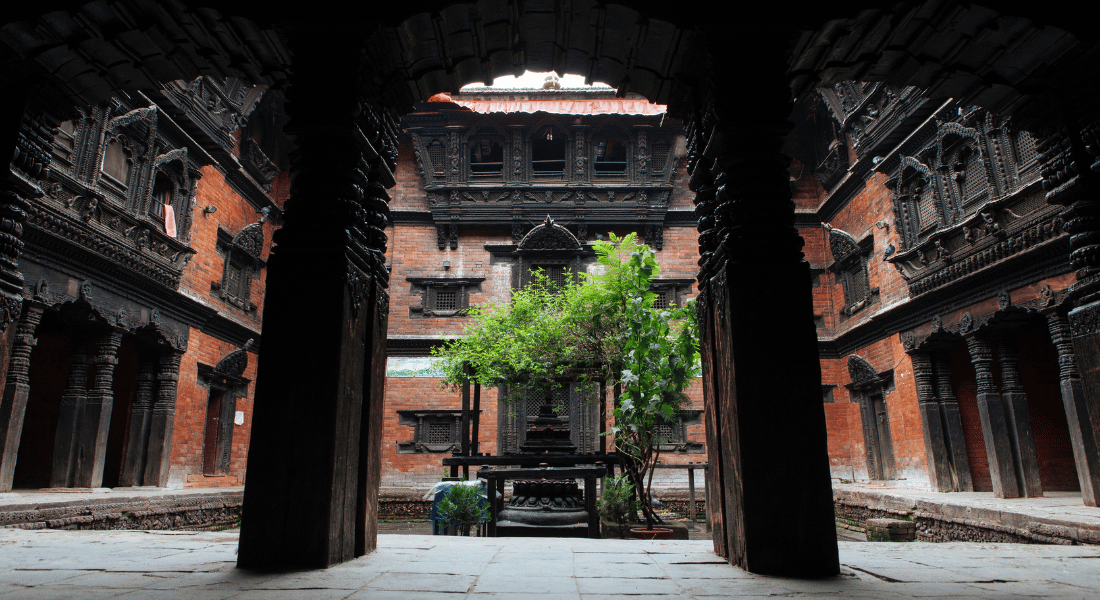
Kumari Ghar, also known as Kumari Bahal, which translates to Kumari House, is the residential landmark for the living goddess Kumari, which is believed to be the manifestation of the goddess Taleju. The architecture was built in 1757 by King Jaya Prakash Malla; it is by far the most beautiful architecture you will come across inside Durbar Square. The Kumari Ghar is a three-storied quadrangle building, meaning it has a central opening space/courtyard surrounded by walls on all sides. In the center of the courtyard is a miniature stupa dedicated to the Hindu deity Saraswati, who is believed to be the goddess of learning. Besides the spiritual significance, the architectural design is mind-blowing too, as the building is lavishly decorated with fine woodwork, which can be seen in several windows. The dark black windows, which are intricately carved, stand out with the red brick walls. On the third floor are five bay windows, in which the Kumari appears from time to time during special occasions to bless the people and the king with her guardian priestess for example, during Indra Jatra.
Gaddi Baithak
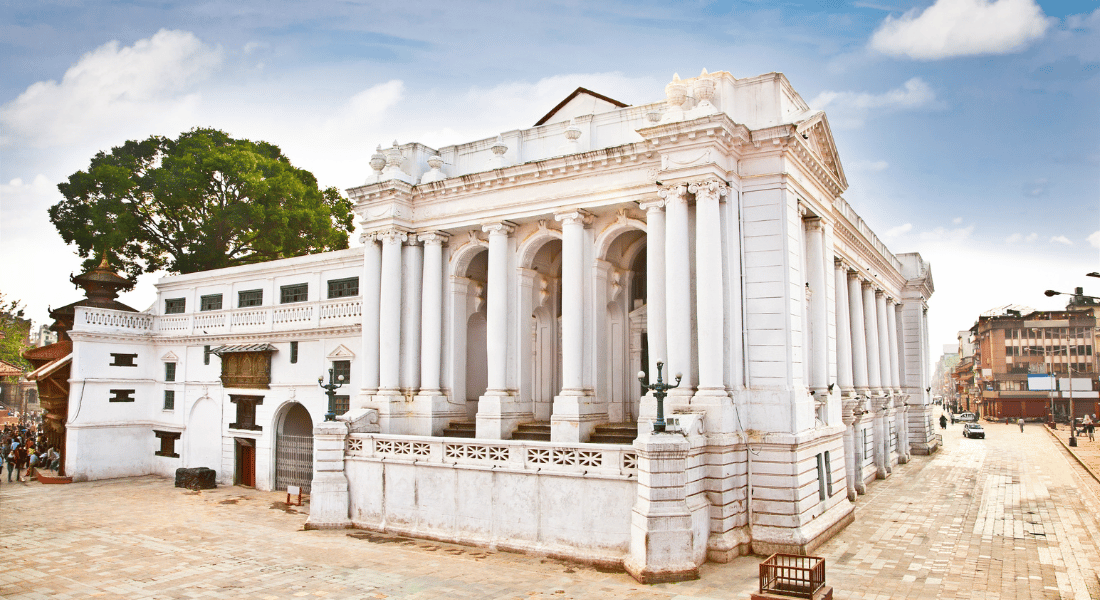
Gaddi Baithak, which translates to the royal seat, is a whitewashed, European colonial-style neoclassical building. It was built as a part of the Palace by Chandra Shamsher in 1908 A.D. during the reign of Prithivi Bir Bikram Shah. It is located on the east side of the palace, surrounded by traditional landmarks. This place was used for important events such as royal coronation and to welcome important personnel from different countries.
Festivals and Events
Kathmandu Durbar Square is one of the most culturally significant places, as every year the area hosts some of the biggest traditional festivals. Kathmandu has the highest concentration of Newars, who are the natives of here and are known for their extravagant festivals and rich history in arts and culture. Every year they celebrate numerous festivals locally known as Jatras and some of the most significant events are hosted here, which are listed below.
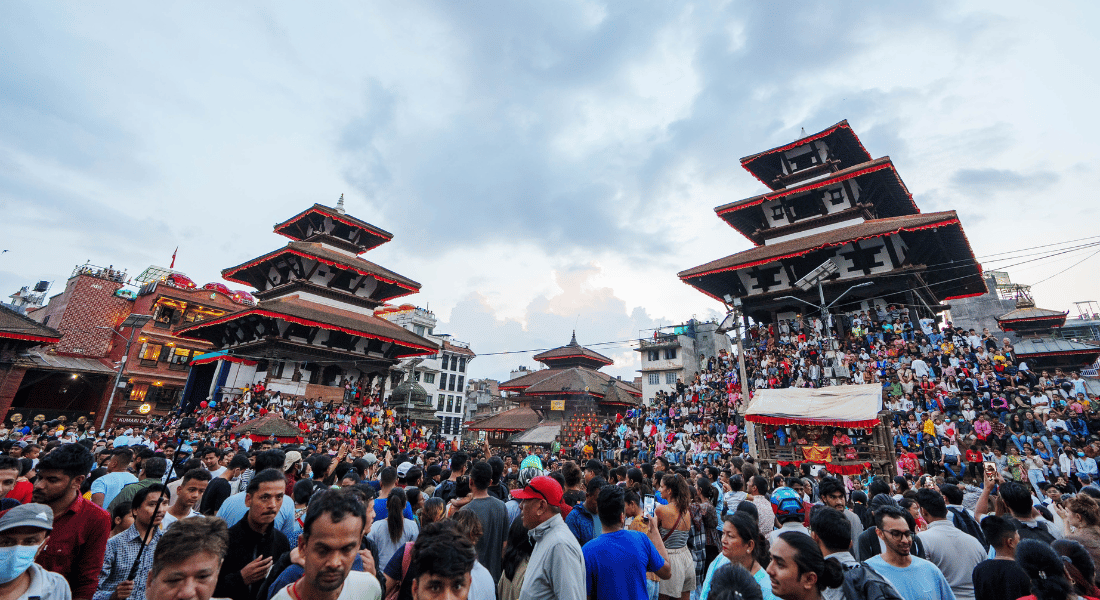
Gai Jatra
Gai Jatra, which is also known as Sa-Pura, translates to Cow Pratipada in the Newari language, where the kids are dressed as cows and go on a parade through the streets of the Kathmandu Valley to honor their deceased ones who have died in the previous year. This cow carnival was started by King Pratap Malla in 1671 to console his grieving wife when his son Chakravartendra Malla died an untimely death, along with cheering the general public. He started this tradition to help ascend his son and the deceased ones to the next life while bringing some joy and relief to the sorrow of the deceased family. The tradition has evolved with time and includes humor which pokes the societal norms making it a unique blend of mourning and laughter.
Learn More: Gai Jatra
Indra Jatra
Indra Jatra, also known as Yenya Punhi, is a celebration of Kathmandu that is derived from the Newari terms "Ye," which means Kathmandu, "Ya," which means celebration, and Punhi, which means full moon, which means Kathmandu's birthday. Indra Jatra is one of the biggest festivals for the Newars (Natives of Kathmandu) and is grandly celebrated. The event consists of two major events, Indra Jatra and Kumari Jatra, featuring other fascinating events such as masked dances of deities and demons displaying sacred images and idols in honor of the Hindu deity Indra. Another one, Kumari Jatra, where the living Goddess Kumari is carried in a chariot round the Kathmandu Durbar Square. The festival is celebrated for 8 whole days with small events such as displaying the mask of Bhairab, raising the pole (Yosin/Lingo), and other significant events.
Learn More: Indra Jatra
Seto Machhindranath Jatra
Seto Machhindranath, also known as Janabaha Dyo, Avalokitesvara, Karunamaya, and Guanyin, is worshipped by both Hindus and Buddhists and is called the god of rain. Its temple is located between Asan and Indra Chowk, which was established in the 10th century. Seto Machhindranath jatra is one of the important celebrations for Newari communities and they celebrate it lavishly. The celebration is 3 days long and follows several events such as traditional music, dance, and performance that showcase the ancient rich culture and heritage of the Newars. During the Jatra, the idol of Seto Machhindranath is placed on a large decorated chariot, traditionally 32 hands tall, and pulled through Kathmandu's alleys and streets in a parade. It was celebrated to bring rain and ensure agricultural prosperity for centuries.
Holi
Holi, the festival of colors, is a Hindu festival celebrated with zeal in the Kathmandu Durbar Square. It is celebrated to commemorate the victory of Lord Vishnu in his Narasimha (Half Lion Half Human) Avatra over Hiranyakashipu. It is celebrated by applying colour powders and water to one another. There are no traditional activities or events that take place during Holi inside the Kathmandu Durbar Square; however, people gather inside the square and celebrate Holi in a bit more modern way, organizing concerts and other lively activities.
Learn More: Holi Festival in Nepal
How to Reach?
Kathmandu Durbar Square is located in the heart of Kathmandu city, close to some well-known areas such as Jamal and Asan Bazzar, making it the center of the city. A popular landmark near the Kathmandu Durbar Square is the Nepal Airline Corporation office (NAC), which also happens to be the bus stop of the area and one can reach the Square within a walkable distance. You can reach the place by a different kind of vehicle or just walking.
Transportation
You can take your private vehicle towards the square, where you can park the ride at a parking space and explore the area on foot, as there is no direct public transportation to the square. If you do not have your vehicle, you can get a taxi or rickshaw from the Newroad gate, which is located a few minutes away from the NAC Office or RNAC bus stop, and visit the square.
Walking
There are numerous alleys that lead to the plaza; all you need to do is know which one to take if you wish to explore the region on foot. You can reach the square surprisingly from any place, as small alleys inside the Jamal, Asan, and Thamel lead to the square. From Thamel, Jamal, NAC, and Newroad, you may walk directly to the square in around 15 to 20 minutes. Use a Google Map if you are unsure of the route.
Opening Time and Entry Fee
The square premises are open 24/7; however, some monuments inside the square are open from 9 AM to 6 PM. Regarding the entrance fees and opening time, it's separated and the details are given below:
|
Opening Hours |
|
|
Tribhuvan Museum |
09:00 AM to 05:00 PM (Ticket Counter Closes at 04:30 PM) |
|
Durbar Square |
24/7 |
One can get the ticket near the entrance of the square in a booth where you will also get a brochure full of information. You can explore the place by yourself or hire a guide if you think there will be language barriers.
|
Entry Fee |
|
|
SAARC Citizens |
NPR 500 Per Person |
|
Other Nationals |
NPR 1000 Per Person |
|
Nepalese Citizens |
Student Card Discount on Friday |
|
Children Below 10 Years |
Free |
Note: The entrance ticket is only valid for 1 day; however, you can extend the validity by extending your ticket date to match your visa duration for free at the booth.
Best time to Visit
Depending on your preferences, you can visit Kathmandu Durbar Square at any time of day because it is always open. The morning is the ideal time of day to enjoy the square's peaceful atmosphere when there are fewer people around. If you want to experience the tranquil ambiance of the square with fewer people, then the morningtime is perfect. During this time there are fewer people, especially those present to worship and you will get to see the spiritual side filled with tranquility and a spiritual aura. The temple premises will be freshly swept, with people lighting oil or butter lamps and incense sticks. The place will be surrounded by just a few devotees, which provides an amazing opportunity to observe the religious side of the Durbar Square.
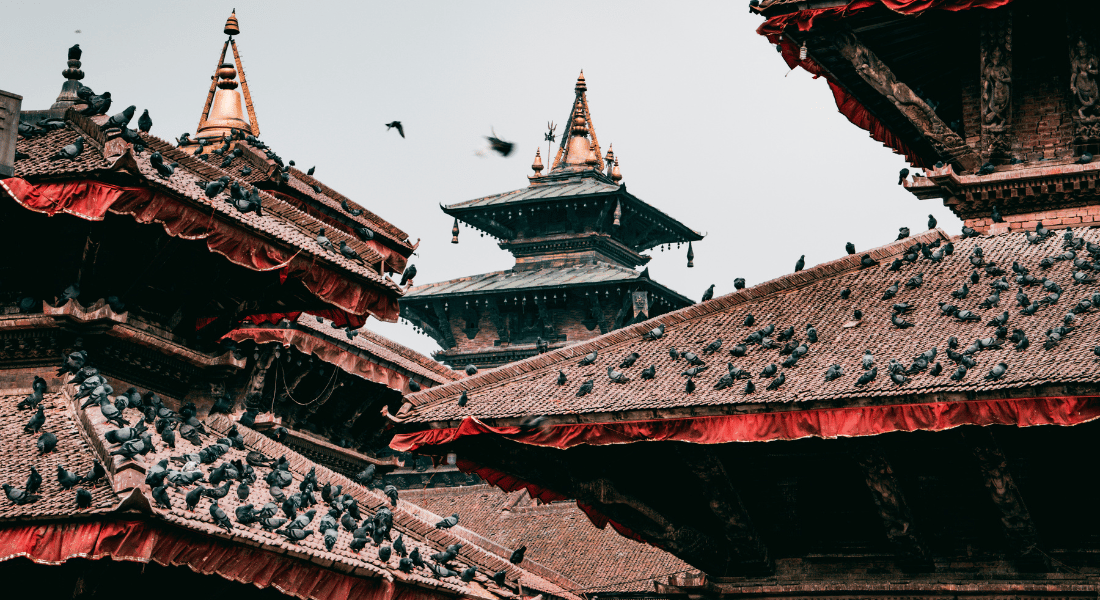
If you don't mind a little bit of a crowd, the daytime is perfect for the visit, as almost all the temples and palace complex will be open, and you can explore the area as you wish. However, depending on the season, especially in summer, it can get quite hot. Despite the heat, the place will be lively with local merchants selling handmade items and other accessories, making the place even more amazing.
Evening time can be ideal for many, as this time the ambiance is calm and cozy, the palace complex is lit up with beautiful lights, and the crowd is gone. The silence of the place is broken by the beauty of the landmarks that stand out in the dim lights. You can sit there and admire the sheer beauty of the historical landmarks.
Practical Tips While Visiting
Before visiting the square, there are things that you might find useful, such as when is the ideal time to visit, its opening hours, and what to do and not which are mentioned below in detail.
-
Hire a guide: Hiring a guide while traveling to a new place is a great idea. It can deal with problems like language barriers and get valuable insight into the historical place, which can help you understand the rich cultural significance of the place and many more.
-
Comfortable and respectful attire: While you can wear any piece of clothing/footwear of your choice, keep in mind that Kathmandu Durbar Square is a large area with several monuments that you will have to explore by foot so comfortable shoes will be your best friend. Regarding the clothes, as the square consists of religious landmarks, it's suggested you wear a bit of respectful clothing that covers most of your body, which will also help you not get unwanted glares from people.
-
Cash or Card: Inside the Square, you will find numerous local vendors selling handmade items such as jewelry and decor items and most of them would prefer cash over cards. Even though people might accept card payment, transfers will deduct a certain amount so carrying cash is a great idea.
-
Be aware of the surroundings: The area can get quite crowded at times, such as in the holiday seasons, especially during festivals so keep an eye on your belongings and safety as it will get really crowded.
-
Respect people's privacy: while you are inside the square, you might want to capture the moment of the historical beauty but be aware of the policy. You are not allowed to take photos and videos inside the temples and palaces and also ask for permission before taking pictures of the locals, as some might get offended and get you in trouble. Respect other’s privacy.
Conclusion
Kathmandu Durbar Square or Hanuman Dhoka Palace Square is one of the most beautiful palace complexes, which is also listed in the UNESCO World Heritage site, as several monuments were built hundreds of years back. These are not mere landmarks but the backbone of Nepal’s rich culture, heritage, art, and history. It is one of those few places where the traditions are still carried out like back in the days, keeping the belief system alive and vibrant as before. Besides the cultural and spiritual importance, it is the very place where the kings once lived, ruling the country and leaving behind a legacy to remember.
Frequently Asked Questions (FAQs)
Here are some frequently asked questions about Kathmandu Durbar Square:
Who established the Kathmandu Durbar Square?
There is no exact date or name of who and when the Kathmandu Durbar Square was established but it dates back to the Lichhavi period when the Durbar was established which was slowly expanded to the Kathmandu Durbar Square we know today. Kings and Prime Ministers from different dynasties contributed by building beautiful monuments inside the square.
What are Kathmandu Durbar Square's opening hours?
The Kathmandu Durbar Square is open 24/7; however, if you are a foreigner, you might need to take a ticket and the booth is generally open from 09:00 AM to 06:00 AM.
Is the Durbar Square open seven days a week?
Yes, it is open 7 days a week; however, during the festive season, the area will be totally crowded, making it difficult to access.
Can you visit the Tribhuvan Museum with the same permit as Kathmandu Durbar Square?
Yes vistors can visit the Tribhuvan Museum with the same entry permit of the Kathmandu Durbar Square. Be mindful of the opening hours if you want to take your time inside the musem as it opens at 09:00 AM till 05:00 PM.
Are all the monuments that were destroyed during the 2015 Earthquake restored?
No, not all of the monuments that were destroyed during the April 2015 earthquake are restored; however, the restoration process is still going on. Most of the major landmarks are rebuilt, which you can check out during your visit to Kathmandu Durbar Square.
Can you tour Durbar Square in a Rickshaw?
No, Kathmandu Durbar Square is a strictly pedestrian area; however, you can take a rickshaw to a nearby area and then explore the Durbar Square on foot. You might see a few bikes here and there that are not allowed but people can be dumb and ignorant sometimes.


